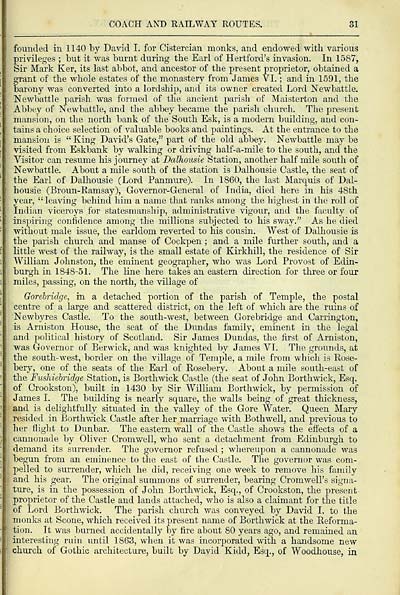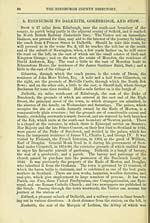Download files
Complete book:
Individual page:
Thumbnail gallery: Grid view | List view

COACH AND RAILWAY ROUTES. 31
founded in 1140 by David I. for Cistercian monks, and endowed with various
privileges ; but it was burnt during the Earl of Hertford's invasion. In 1587,
Sir Mark Ker, its last abbot, and ancestor of the present proprietor, obtained a
grant of the whole estates of the monastery from James VI. ; and in 1591, the
barony was converted into a lordship, and its owner created Lord Newbattle.
Newbattle parish was formed of the ancient parish of Maisterton and the
Abbey of Newbattle, and the abbey became the parish church. The present
mansion, on the north bank of the South Esk, is a modern building, and con-
tains a choice selection of valuable books and paintings. At the entrance to the
mansion is " King David's Gate," part of the old abbey. Newbattle may be
visited from Eskbank by walking or driving half-a-mile to the south, and the
Visitor can resume his journey at Dalhousie Station, another half mile south of
Newbattle. About a mile south of the station is Dalhousie Castle, the seat of
j the Earl of Dalhousie (Lord Panmure). In 1860, the last Marquis of Dal-
housie (Broun-Ramsay), Governor-General of India, died here in his 48th
year, " leaving behind him a name that ranks among the highest in the roll of
Indian viceroys for statesmanship, administrative vigour, and the faculty of
inspiring confidence among the millions subjected to his sway." As he died
without male issue, the earldom reverted to his cousin. West of Dalhousie is
the parish church and manse of Cockpen ; and a mile further south, and a
little west of the railway, is the small estate of Kirkhill, the residence of Sir
William Johnston, the eminent geographer, who was Lord Provost of Edin-
burgh in 1848-51. The line here takes an eastern direction for three or four
miles, passing, on the north, the village of
Gorebridge, in a detached portion of the parish of Temple, the postal
centre of a large and scattered district, on the left of which are the ruins of
Newbyres Castle. To the south-west, between Gorebridge and Carrington,
is Arniston House, the seat of the Dundas family, eminent in the legal
and political history of Scotland. Sir James Dundas, the first of Arniston,
was Governor of Berwick, and was knighted by James VI. The grounds, at
the south-west, border on the village of Temple, a mile from which is Rose-
bery, one of the seats of the Earl of Rosebery. About a mile south-east of
the Fushiebridge Station, is Borthwick Castle (the seat of John Borthwick, Esq.
of Crookston), built in 1430 by Sir William Borthwick, by permission of
James I. The building is nearly square, the walls being of great thickness,
and is delightfully situated in the valley of the Gore Water. Queen Mary
resided in Borthwick Castle after her marriage with Bothwell, and previous to
her flight to Dunbar. The eastern wall of the Castle shows the effects of a
cannonade by Oliver Cromwell, who sent a detachment from Edinburgh to
demand its surrender. The governor refused ; whereupon a cannonade was
begun from an eminence to the east of the Castle. The governor was com-
pelled to surrender, which he did, receiving one week to remove his family
and his gear. The original summons of surrender, bearing Cromwell's signa-
ture, is in the possession of John Borthwick, Esq., of Crookston, the present
proprietor of the Castle and lands attached, who is also a claimant for the title
of Lord Borthwick. The parish church was conveyed by David I. to the
monks at Scone, which received its present name of Borthwick at the Reforma-
tion. It was burned accidentally by fire about 80 years ago, and remained an
I interesting ruin until 1863, when it was incorporated with a handsome new
church of Gothic architecture, built by David Kidd, Esq., of Woodhouse, in
founded in 1140 by David I. for Cistercian monks, and endowed with various
privileges ; but it was burnt during the Earl of Hertford's invasion. In 1587,
Sir Mark Ker, its last abbot, and ancestor of the present proprietor, obtained a
grant of the whole estates of the monastery from James VI. ; and in 1591, the
barony was converted into a lordship, and its owner created Lord Newbattle.
Newbattle parish was formed of the ancient parish of Maisterton and the
Abbey of Newbattle, and the abbey became the parish church. The present
mansion, on the north bank of the South Esk, is a modern building, and con-
tains a choice selection of valuable books and paintings. At the entrance to the
mansion is " King David's Gate," part of the old abbey. Newbattle may be
visited from Eskbank by walking or driving half-a-mile to the south, and the
Visitor can resume his journey at Dalhousie Station, another half mile south of
Newbattle. About a mile south of the station is Dalhousie Castle, the seat of
j the Earl of Dalhousie (Lord Panmure). In 1860, the last Marquis of Dal-
housie (Broun-Ramsay), Governor-General of India, died here in his 48th
year, " leaving behind him a name that ranks among the highest in the roll of
Indian viceroys for statesmanship, administrative vigour, and the faculty of
inspiring confidence among the millions subjected to his sway." As he died
without male issue, the earldom reverted to his cousin. West of Dalhousie is
the parish church and manse of Cockpen ; and a mile further south, and a
little west of the railway, is the small estate of Kirkhill, the residence of Sir
William Johnston, the eminent geographer, who was Lord Provost of Edin-
burgh in 1848-51. The line here takes an eastern direction for three or four
miles, passing, on the north, the village of
Gorebridge, in a detached portion of the parish of Temple, the postal
centre of a large and scattered district, on the left of which are the ruins of
Newbyres Castle. To the south-west, between Gorebridge and Carrington,
is Arniston House, the seat of the Dundas family, eminent in the legal
and political history of Scotland. Sir James Dundas, the first of Arniston,
was Governor of Berwick, and was knighted by James VI. The grounds, at
the south-west, border on the village of Temple, a mile from which is Rose-
bery, one of the seats of the Earl of Rosebery. About a mile south-east of
the Fushiebridge Station, is Borthwick Castle (the seat of John Borthwick, Esq.
of Crookston), built in 1430 by Sir William Borthwick, by permission of
James I. The building is nearly square, the walls being of great thickness,
and is delightfully situated in the valley of the Gore Water. Queen Mary
resided in Borthwick Castle after her marriage with Bothwell, and previous to
her flight to Dunbar. The eastern wall of the Castle shows the effects of a
cannonade by Oliver Cromwell, who sent a detachment from Edinburgh to
demand its surrender. The governor refused ; whereupon a cannonade was
begun from an eminence to the east of the Castle. The governor was com-
pelled to surrender, which he did, receiving one week to remove his family
and his gear. The original summons of surrender, bearing Cromwell's signa-
ture, is in the possession of John Borthwick, Esq., of Crookston, the present
proprietor of the Castle and lands attached, who is also a claimant for the title
of Lord Borthwick. The parish church was conveyed by David I. to the
monks at Scone, which received its present name of Borthwick at the Reforma-
tion. It was burned accidentally by fire about 80 years ago, and remained an
I interesting ruin until 1863, when it was incorporated with a handsome new
church of Gothic architecture, built by David Kidd, Esq., of Woodhouse, in
Set display mode to: Large image | Transcription
Images and transcriptions on this page, including medium image downloads, may be used under the Creative Commons Attribution 4.0 International Licence unless otherwise stated. ![]()
| Scottish Post Office Directories > Counties > Midlothian (Edinburghshire) > Edinburgh county directory > (37) |
|---|
| Permanent URL | https://digital.nls.uk/85990579 |
|---|
| Description | Directories of individual Scottish counties or parts of counties. |
|---|
| Description | Around 700 Scottish directories published annually by the Post Office or private publishers between 1773 and 1911. Most of Scotland covered, with a focus on Edinburgh, Glasgow, Dundee and Aberdeen. Most volumes include a general directory (A-Z by surname), street directory (A-Z by street) and trade directory (A-Z by trade). |
|---|


